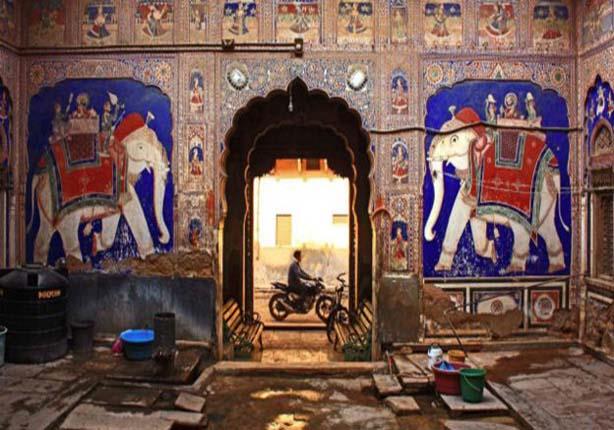A lover, a documentarian or a voyeur?
A new exhibition lets us question Degas’ fixation with ballet.
Edgar Degas (French, 1834–1917). Frieze of Dancers (Danseuses attachant leurs sandales), c. 1895. Oil on fabric. 27 9/16 × 78 15/16″ (70 × 200.5 cm). The Cleveland Museum of Art, Gift of the Hanna Fund.
In a game of word association, the name Edgar Degas provokes a stream of familiar responses: painter, French, Impressionism. Maybe absinthe and naked women, too. But probably, before you even mutter “artist,” you’ve let “dance” or “ballet” roll off your tongue. In fact, as you read this, you’re likely envisioning ladies in tutus bowing to crowds and lunging from barres, stuck with their arms in perpetual fifth position.
Degas, born to a moderately wealthy family in Paris in 1834, was obsessed with dance — he is said to have described his soul as a worn pink satin ballet shoe — but less so with the dancers. “People call me the painter of dancing girls,” Degas once mused to his Paris art dealer Ambroise Vollard. “It has never occurred to them that my chief interest in dancers lies in rendering movement and painting pretty clothes.”
A delightful contrarian, Degas was not a fan of the en plein air tendencies of Impressionism (he, for that matter, rejected the movement’s name in favor of referring to himself as a realist), preferring to work indoors. He rendered his women nameless, sometimes faceless, focusing on the ways their bodies became blurry when they fluttered across a stage or rehearsal space. With an eye forever to the floor, his ominous presence is still felt in the works, as if he’s a wildlife photographer documenting the quirks of a species he’s yet to understand.
Edgar Degas (French, 1834–1917). Dancer Onstage with a Bouquet, c.1876. Pastel over monotype on laid paper. Plate: 10 5/8 × 14 7/8 in. (27 × 37.8 cm). Private collection.
“His obsession with dancers lasted four decades, took him from the academy to modernity (and through two opera houses),” Roberta Smith wrote in The New York Times over a decade ago, “and resulted in roughly half of his entire artistic output, some 1,500 works.” The legacy endures today.
But back to that first identifier — painter. Degas was indeed a painter, as well as a sculptor, draftsman and printer. In the latter medium, he dabbled in lithography, but found a niche in monotypes, a kind of printmaking that involves painting or drawing directly on a non-absorbent surface before transferring the image, by pressing, onto a piece of paper. He described the monotype like he would a view from a train;always in motion.
Degas monotypes are currently on view at New York’s Museum of Modern Art, in an expansive exhibition dubbed “A Strange New Beauty.” There, patrons can pore over 120 monotypes and nearly 60 related works, including paintings, drawings, pastels, sketchbooks, and other prints. “Captivated by the monotype’s potential, Degas took the medium to new and radical heights,”
recounts in an exhibition description. “The resulting works are characterized by enigmatic and mutable forms, luminous passages emerging from deep blackness, and a heightened sense of tactility.”
Edgar Degas (French, 1834–1917). The Ballet Master (Le Maître de ballet), c. 1876. White chalk or opaque watercolor over monotype on paper. Plate: 22 1/4 x 27 9/16 in. (56.5 x 70 cm), sheet: 24 7/16 x 33 7/16 in. (62 x 85 cm). National Gallery of Art, Washington, D.C. Rosenwald Collection, 1964.
To create the monotypes, Degas would sometimes use a dauber — a piece of felt folded in on itself like a pinwheel pastry — to lather his surface in black ink, etching out a scene with the end of a paintbrush, a piece of fabric, his own hands. These monotypes are called dark fields.
Other times, in his light fields, he’d apply positive chunks of colors with a brush or rag, crafting both landscapes and portraits of dancers. He’d push the physical limits of his prints, producing not just one image, as the name monotype would suggest, but several. The second and third attempts would appear as degraded, phantom versions of their originals that he’d punctuate with pastels after the print, adding the deep blue-green and subtle pink that dominated his canvases too.
Like in his paintings and pastels, ballerinas appear in the monotypes as Degas’ inescapable subjects. Rarely defined, always teetering on the edge of some pose or another, the women are usually indistinguishable as they crowd onto benches and swarm onto stages. Their ritual and exhaustion bleeds through the prints, more than their satisfaction or ingenuity; the intricacies of tulle and pinches of silk take precedence over the details of an expression or gaze.
Edgar Degas (French, 1834–1917). Ballet Scene (Scène de ballet), c. 1879. Pastel over monotype on paper. Plate: 8 x 16 in. (20.3 x 40.6 cm). William I. Koch Collection.
In this way, the universe of Degas offers glimpses into theaters not unlike peeks into brothels. In “Waiting for a Client” and “Three Women in a Brothel,” the female figures are shown with their backs to the viewer, splashes of color highlighting thigh-high socks and decor, rather than lips or eyes or flesh.
notes in its exhibition placards, Degas’ brothel scenes are distinct from the depictions of other late 19th-century artists who drew sex workers as perfect, untouched beings in repose. Like his dancers, Degas’ brothel women sometimes appear unbothered, casually adjusting clothing and lounging on furniture. At other times, they appear hesitant, anxious, their backs stiff and their faces obscured. In art critic J.K. Huysmans’ opinion, Degas “brought ... to his studies of nudes, an attentive cruelty, a patient hatred.” He abandoned “the idol ... woman, whom he debases as he depicts her.”
“I have perhaps too often considered woman as an animal,” Degas once admitted.
“It would be easy to see Degas as a misogynist, cold and voyeuristic, and there is truth in this,” art critic Jonathan Jones wrote. “Yet Degas’ very preoccupation with the physical lives of women made him look beyond the conventions of 19th-century bourgeois life; his very desire to spy made him look at the poor, the marginalized, and see beneath the lie of the middle-class home.”
Edgar Degas (French, 1834–1917). Waiting for a Client, 1879. Charcoal and pastel over monotype on paper. Plate: 6 3/8 × 4 3/4 in. (16.2 × 12.1 cm). Private Collection.
Perhaps this is a forgiving conclusion, a sentiment that belies the gender dynamics of the time. Ballerinas in the early 19th century were often of little means, paid to entertain audiences of mostly men, men who rarely saw such unclothed limbs in public settings. Their lives, ruled both by the athletically demanding rigor of dance and the financially trying reality of unmarried life, were influenced by a wafting desire to pair with a wealthy patron. And there were many, called abonnés, who were given access backstage to the halls and dressing rooms. Degas spied on this, too.
“These women of mine are ... unconcerned by any other interest than those involved in their physical condition,” Degas described, “it is as if you looked through a keyhole.”
This is a darker place to settle, a more callous interpretation of the listlessness of Degas’ work. But one that’s hard to ignore when the only bodies eyed in halls of monotypes are frequently those of ladies, clothed and not, their skirts more refined than their cheekbones. If one tries to see Degas as more than a dance master, what kind of anthropologist was he? Was he breaking through the veneer of well-to-do life in Paris, exposing the the ways women struggled to live? Or was he working with what he had? In an uncaring quest to capture the female figure, he had only two options — head to the brothel or the ballet, for there you could see shoulders and knees, unlike prim public life.
Of this, the poet Paul Valéry said Degas was “divided against himself; on the one hand driven by an acute preoccupation with truth, eager for all the newly introduced and more or less felicitous ways of seeing things and of painting them; on the other hand possessed by a rigorous spirit of classicism, to whose principles of elegance, simplicity and style he devoted a lifetime of analysis.”
Edgar Degas (French, 1834–1917). Three Women in a Brothel, Seen from Behind (Trois filles assises de dos), c. 1877–79. Pastel over monotype on paper. 6 5/16 x 8 7/16 in. (16.1 x 21.4 cm). Musée Picasso, Paris.
There is certainly more to see than dance, less beguiling and equally representative of Degas’ pure knack for making monotypes. His landscapes deftly blend color and form, showing how Degas could abstract hills and fields into curious color blocks. His cropped portraits of upper-class theatergoers give ghostly impressions of what it was like to meander through the halls of the Paris Opera. Viewers can hold a magnifying glass up to the small frames, spying on the thin lines that separate body from background, treetop from muted sky, the remaining pieces of Degas’ historical fiction.
“A painting requires a little mystery, some vagueness, and some fantasy,” Degas is quoted as saying. “When you always make your meaning perfectly plain you end up boring people.”
In the end, the many works, crammed into but a few rooms on the museum’s sixth floor, reveal the storied repetition of a man — never married, plagued by diminishing sight, and later prone to anti-Semitism before his death in 1917 — whose obsessions never faded. He remains as perplexing to us and his ballerinas, an unsolved mystery of art, and perhaps that’s the way he intended it.
“Edgar Degas: A Strange New Beauty“ will be on view at the Museum of Modern Art in New York City from March 26 until July 24, 2016.
Edgar Degas (French, 1834–1917). Landscape with Rocks (Paysage avec rochers), 1892. Pastel over monotype in oil on wove paper. Sheet: 10 1/8 × 13 9/16″ (25.7 × 34.4 cm). High Museum of Art, Atlanta, Purchase with High Museum of Art Enhancement Fund.
Edgar Degas (French, 1834–1917). Dancers Coming from the Dressing Rooms onto the Stage (Et ces demoiselles fretillaient gentiment devant la glace du foyer), c. 1876–77. Proposed illustration for The Cardinal Family (La Famille Cardinal). Pastel over monotype on paper. Plate: 8 3/8 × 6 1/4 in. (21.2 × 15.8 cm). Schorr Collection.
Edgar Degas (French, 1834–1917). Autumn Landscape (L’Estérel), 1890. Monotype in oil on paper. Plate: 11 7/8 x 15 3/4 in. (30.2 x 40 cm), sheet: 12 1/2 x 16 1/4 in. (31.8 x 41.3 cm). Private collection.
Edgar Degas (French, 1834–1917). Café-Concert Singer (Chanteuse de café-concert), c. 1877. Monotype on paper mounted on board. Plate: 7 5/16 x 5 1/16 in. (18.5 x 12.8 cm), sheet: 9 1/4 x 7 1/16 in. (23.5 x 18 cm). Private collection.
Edgar Degas (French, 1834–1917). Heads of a Man and a Woman (Homme et femme, en buste), c. 1877–80. Monotype on paper. Plate: 2 13/16 x 3 3/16 in. (7.2 x 8.1 cm). British Museum, London. Bequeathed by Campbell Dodgson.
Edgar Degas (French, 1834–1917). Three Ballet Dancers (Trois danseuses), c. 1878-80. Monotype on cream laid paper. Plate: 7 13/16 × 16 3/8″ (19.9 × 41.6 cm). Sterling and Francine Clark Art Institute, Williamstown, Massachusetts.






















































.jpg?format=300w)













































































































































































































